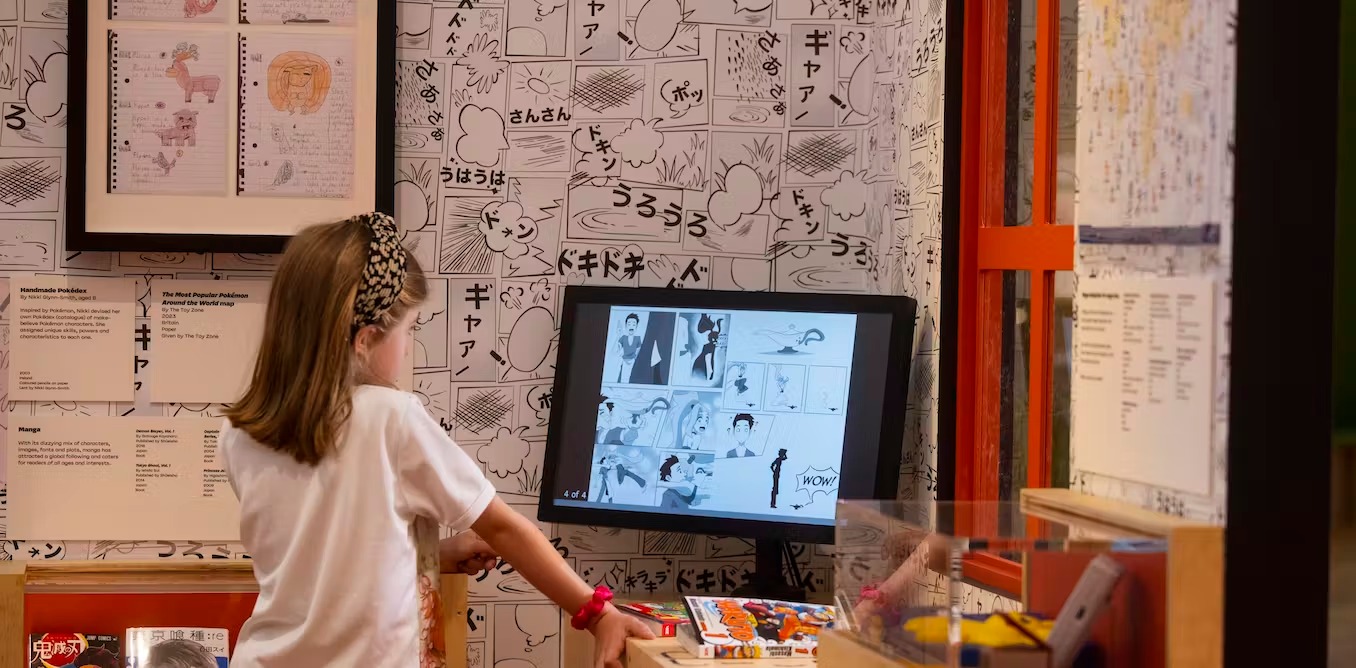Japan: Myths to Manga at the Young V&A is loosely divided into four parts: sky, sea, forest and city. The underlying theme of the exhibition is showcasing how traditions developed in these contexts relate to contemporary Japanese culture. Japan’s dramatic natural landscapes are displayed as the inspiration behind the country’s art and culture.
Visiting the show entails taking a journey from traditional culture (such as kimonos, Hokusai’s “Big Wave” and Japanese monsters known as Yokai) to contemporary culture (such as manga, anime and urban legends). The exhibition explores how those traditional spirits are still alive in contemporary Japan.
In doing so, the exhibition avoids the trap of Orientalist representations of Japan: a different culture is presented without any sweet exoticism.
To engage young people and families, there are several interactive exhibits. This includes Taiko (traditional drums) that anybody can try to play, manga drawing, and origami folding. On the surface, the exhibition seems to appeal primarily to children. However, there is plenty to enjoy for adult visitors too, who might notice some interesting techniques of repurposing and retelling at play.
For example, in the “sea” space, Katsushika Hokusai’s iconic The Great Wave Off Kanagawa print is well known. But there is also a parody of it by contemporary artist Toru Ishii, which epitomises the essence of contemporary Japan.
Ishii’s wave almost swallows Tokyo Sky Tree (a new landmark building) and Tokyo city. Ink bottles, pens and desks are dancing in the wave, led by a knight on a horse. The office workplace has become a place of war. This echoes a well-known advertising slogan for the Japanese energy drink Regain: “Can you fight for 24 hours?”
Although the translated title of the piece is Going Work War, the painting has a second message about ocean pollution, as the giant wave swallows all kinds of things that do not belong.
Resonating with Ishii’s painting, the clothes made by the 12-year-old artist Coco-Pink shown in the “city” space speak to the audience. Conscious of global environmental issues, Coco-Pink creates new extravagant outfits using old clothes, reducing waste through her creations.
Cultural translation
The exhibition can be interpreted as a work of cultural translation. Artists translated their ideas into artwork. Old myths were passed on orally for many hundreds of years, before being translated into the scripts displayed in the exhibition. The curators translated the exhibits by placing them into contexts known to the audience: sky, sea, forest and city. The visitors are offered an impression of Japan as balanced between its nature and cities.
One particularly strong example of this work of translation is in the “sky” section. Its exhibits relate to a Japanese tradition called Otsukimi, which involves watching the beautiful full moon while enjoying rice cakes called Tsukimi Dango (“The Rabbit and the mochi”). It’s said that careful observers can see the image of a rabbit making rice cakes on the moon’s surface (“The Rabbit and the moon”).
This tradition travelled to Japan from China in the Heian period (794-1185). Naoko Takeuchi, a famous manga author, translated this myth and tradition into her internationally known manga (later also anime): Sailor Moon (1991-1997).
Trailer for a recent Sailor Moon movie on Netflix.
The girl fighters of Sailor Moon, displayed in five exhibits of manga sketches, all wear sailor uniforms. Sailor style is a popular school uniform among Japanese girls. It is a translation of uniforms worn by sailors in England and was first adopted by a girls’ school in Kyoto in 1920, as part of a wave of democratisation during the Taisho period (1912-1926).
The name of the manga’s protagonist, Tsukino Usagi, translates as “Moon’s Rabbit”. As much as the Japanese admire the power of the Sun (symbolised by a red disk in the Japanese flag), they are also attracted by the mystical power of the moon. Sailor Moon reflects the understanding of the moon as being female in Japan, but at the same time translates it into a female image of strength and mythical power, fighting for justice.
Attentive visitors understand that they are offered a translated image of Japan as they walk through different levels. It is up them to decide which levels to pick up and translate into new meaning for themselves.



 Office design isn’t keeping up with post-COVID work styles - here’s what workers really want
Office design isn’t keeping up with post-COVID work styles - here’s what workers really want  Europe Confronts Rising Competitive Pressure as China Accelerates Export-Led Growth
Europe Confronts Rising Competitive Pressure as China Accelerates Export-Led Growth  Bitcoin Defies Gravity Above $93K Despite Missing Retail FOMO – ETF Inflows Return & Whales Accumulate: Buy the Dip to $100K
Bitcoin Defies Gravity Above $93K Despite Missing Retail FOMO – ETF Inflows Return & Whales Accumulate: Buy the Dip to $100K  India’s IT Sector Faces Sharp 2025 Valuation Reset as Mid-Caps Outshine Large Players
India’s IT Sector Faces Sharp 2025 Valuation Reset as Mid-Caps Outshine Large Players  Every generation thinks they had it the toughest, but for Gen Z, they’re probably right
Every generation thinks they had it the toughest, but for Gen Z, they’re probably right  Locked up then locked out: how NZ’s bank rules make life for ex-prisoners even harder
Locked up then locked out: how NZ’s bank rules make life for ex-prisoners even harder  European Luxury Market Set for a Strong Rebound in 2026, UBS Says
European Luxury Market Set for a Strong Rebound in 2026, UBS Says  Citi Sets Bullish 2026 Target for STOXX 600 as Fiscal Support and Monetary Easing Boost Outlook
Citi Sets Bullish 2026 Target for STOXX 600 as Fiscal Support and Monetary Easing Boost Outlook  The ghost of Robodebt – Federal Court rules billions of dollars in welfare debts must be recalculated
The ghost of Robodebt – Federal Court rules billions of dollars in welfare debts must be recalculated 




























